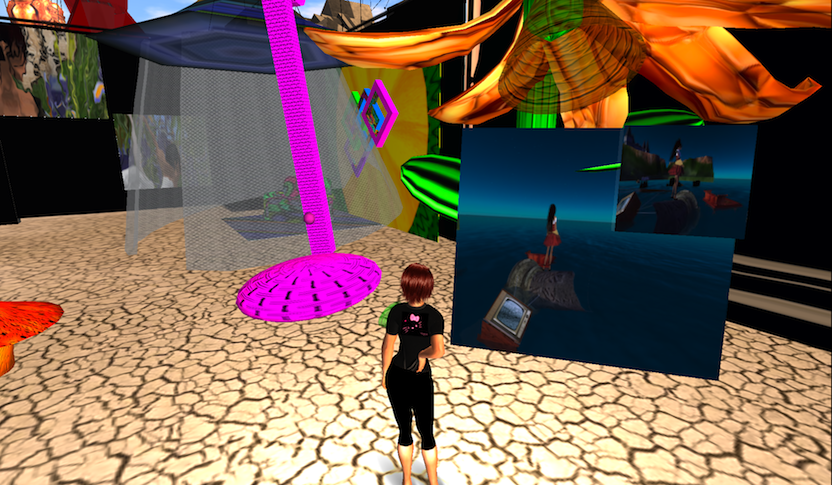Introduction

multimodal exhibition space in Burn2 (2010)
Upon entering a virtual world such as Second Life, we experience a hypermediated environment in which the newer technology seeks to make itself transparent, or holds the promise of transparency, on several levels. On the one hand, the medium invites us to let it erase its presence so that we can experience immersion, or immediacy, in the virtual environment. As our avatar, the presence we construct to interact in the virtual environment, interacts with its landscape, we are asked to suspend the distance between that computer screen and our presence, and to accept the presence of that landscape as real. Hypermedia is also evoked by the manner in which we encounter older forms of media in the virtual world. Common experiences are through “builds”—virtual architecture shaped to form towns, cities, neighborhoods, farms, beachfronts, gardens, and schools, among others—and embedded functional television sets, music productions, DJ booths, photography studios, and art museums, all created by users of the program. We also see countless replicated schools, often complete with desks and the props of real classrooms, meant to be used for online educational encounters. I argue that there are better uses of this environment for new media educators than virtual campuses, and that these opportunities parallel trends in ePortfolio learning through student-initiated “creating, evidencing, connecting, and reflecting” practices (Yancey 28). In fact, the virtual portfolio, or vPortfolio, might extend and enhance the learning, showcase, and assessment potentialities of ePortfolio learning.
In the first part of this essay, I discuss the nature of hypermedia as defined by Jay Robert Bolter and Richard Grusin, demonstrate how hypermedia is manifested in Second Life, and indicate how the awareness of media (as opposed to the experience of media as transparent) is the place where serious learning takes place. In the second part, I introduce James Robert Schirmer’s theory of acquiring literacy through the engagement of video games as a process of remediation (as players develop rhetorical skills through a non-traditional medium), and discuss how Second Life (a different kind of virtual environment) differs from video games in its lack of ability to secure students' engagement, a potential problem for educators. In this section, I also show how Second Life nonetheless presents a better example of James A. Inman’s “cyborg literacy” than video games in that Second Life affords users the freedom to do whatever they want whenever they want within the limiting structure of the platform. In the final section, I evoke Burn2 (Second Life’s annual virtual recreation of the Burning Man festival) as a model for creating engagement within Second Life that could be utilized within a virtual portfolio system by linking students’ builds in Second Life to their online web-based portfolios.
How one experiences this hypermediated environment varies with the level of one’s participation in the creation of the environment. The more one creates content in Second Life—whether that be of virtual objects, scripts for object or avatar performance, or social content such as virtually-based businesses or networks—the more wonderful the environment seems and the less likely one is to get hung up on its inadequacies and glitches. But a common reaction to the platform, after the initial wonder of its newness, is frustration with its inability to make itself transparent as a medium. Movement must be learned, and communication is filtered through text chat, voice over IP, or programmed gestures. Objects and clothes must “rez” (the process of rendering objects and textures in the virtual world, experienced as the lag between the server containing the code and the perception of a viewer from the computer screen receiving its image; this usually appears to the viewer as a transformation from a gray blob to a fully visible item) because they are stored on a server and not the client computer. Textures may look flat due to low resolution or improper rezzing; parts of the avatar’s body, face, or clothing may not look complete due to limited rezzing. “Lag” is an almost constant presence, causing movement, transportation, or chat to slow down noticeably. These are typical features of Second Life and not due to any special catastrophe or breakdown. Your typical “newbie” user (noob) will spend a great deal of time learning to navigate the medium of the virtual world, with the goal initially of being able to move through it effortlessly, without having to struggle to accomplish basic tasks of walking, dressing one’s avatar, or creating a simple object.
